Cambodia – Temples of Angkor, March 2011
The most anticipated part of my trip… seeing the Temples of Angkor! Fairly easy to organise a trip, either opt for a Tuk Tuk to take you around, or you can even cycle as the roads are well marked. AC taxis are also available. I opted for a Tuk Tuk. I had read about the various temples earlier so I planned a 3 day itinerary, which I discussed with the Tuk Tuk driver, Vanny. He was really helpful and suggested the route for each day. I chose to do some of the farthest temples on Day 1 so that I don’t run out of time later.
Nothing can really prepare you for what you see at Angkor. If you are interested in history, it’s a world you can get lost in. No matter how dilapidated some of the structures are, they are an unforgettable sight & take you back to a time when life was about god-like worship of kings.
The first temple I went to was Ta Prohm, originally called Rajavihara. Ta Prohm means ‘ancestor Brahma’. Its popular with tourists because nature has virtually take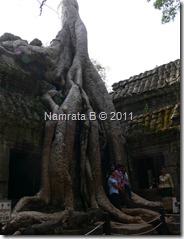 n over the temples, large trees grow out of the structure and make for a unique sight. Ta Prohm is also being restored with help from the Indian govt. It has a lot of headless statues as do almost all the temples, since the temples have been looted through history especially during the Khmer Rouge era. The elaborate carvings on the pillars of apsaras and kings are lovely, and soon became a familiar sight as I visited more temples. Many stones lie on the ground from fallen towers and broken pillars. Next I went to Banteay Srei (Citadel of Women). Began in 967 AD. Considered one of the best temples because of its art. It has beautiful intricate carvings and is made fr
n over the temples, large trees grow out of the structure and make for a unique sight. Ta Prohm is also being restored with help from the Indian govt. It has a lot of headless statues as do almost all the temples, since the temples have been looted through history especially during the Khmer Rouge era. The elaborate carvings on the pillars of apsaras and kings are lovely, and soon became a familiar sight as I visited more temples. Many stones lie on the ground from fallen towers and broken pillars. Next I went to Banteay Srei (Citadel of Women). Began in 967 AD. Considered one of the best temples because of its art. It has beautiful intricate carvings and is made fr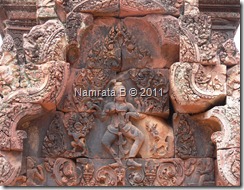 om red sandstone & so is very pretty. Most of the other temples are grey. It was one of my favourites of all the temples I saw. On Nikki’s recommendation (the one I contacted on Couchsurfing) I went to see the Banteay Samre (Citadel of the Samre) (named after the population which lived in the region around Phnom Kulen, to the northeast of Siem Reap). It’s usually skipped by most tourists & I was glad I went here. Like most temples, moats for water form a key part of the temple.
om red sandstone & so is very pretty. Most of the other temples are grey. It was one of my favourites of all the temples I saw. On Nikki’s recommendation (the one I contacted on Couchsurfing) I went to see the Banteay Samre (Citadel of the Samre) (named after the population which lived in the region around Phnom Kulen, to the northeast of Siem Reap). It’s usually skipped by most tourists & I was glad I went here. Like most temples, moats for water form a key part of the temple. 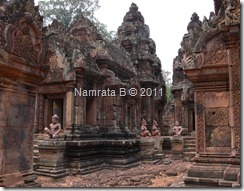 In fact it set in concentric squares, each separated by a moat which is now dry. By now I had started recognising some of the typical temple features. Circular window bars, apsaras on pillars, the triangular towers. But even with all the similarities, each temple is different and has its own charm.
In fact it set in concentric squares, each separated by a moat which is now dry. By now I had started recognising some of the typical temple features. Circular window bars, apsaras on pillars, the triangular towers. But even with all the similarities, each temple is different and has its own charm.
The other temples I saw on the same day were Pre Rup and Banteay Kdei. After all the walking around in the hot & humid weather, I was looking forward to the comfort of my room! There’s a lot of walking and climbing involved so the temples are not a place for kids or older people. Many of the Temples were designed as temple mountains, representing Mount Meru, so the stone steps are high & also uneven. In many cases the steps are not wide enough for the foot, so you have descend and ascend sideways. There’s a slight sense of adventure in climbing up all the steps to the top & well worth it for the view.
Right opposite Banteay Kdei is the Sra Srang, a lake that’s a popular spot to see the sunrise from. This is where I headed on Day 2 at 5 am! As did many others. 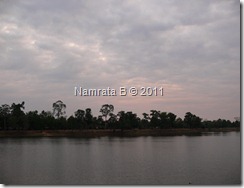 But we were all disappointed as it was a cloudy day & the sun was a sliver of red that went behind the clouds almost as soon as it rose. It was a great way to begin the morning though, sitting there at the lake & watching the sky slowly light up. And even better, all the temples I saw next had no crowd as it was still early. Starting with East Mebon, a 10th century temple dedicated to Shiva, I went next to Neak Pean (the entwined serpents). This was unique & I loved it.
But we were all disappointed as it was a cloudy day & the sun was a sliver of red that went behind the clouds almost as soon as it rose. It was a great way to begin the morning though, sitting there at the lake & watching the sky slowly light up. And even better, all the temples I saw next had no crowd as it was still early. Starting with East Mebon, a 10th century temple dedicated to Shiva, I went next to Neak Pean (the entwined serpents). This was unique & I loved it. 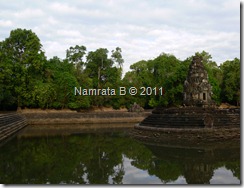 There’s a long boardwalk leading upto it as it has water surrounding it in the monsoon. The temple itself has several pools on all sides – 8 of them – but all dry now. In the centre is the temple, surrounded by water. The entwined serpents are at the base of the central structure, I couldn’t get there as there’s water all around. It looks quaint, surrounded by green trees & its very, very quiet. It is not imposing as it isn’t a grand, tall structure & that adds to its charm. Right after this, I headed to Preah Khan (Sacred Sword) – its largely unrestored so has a lot of rubble. It’s also maze like as it has entrances from all 4 sides – N, S, E, W. Its only when you climb up (through a lot of the rubble) that you see the temple towers, otherwise, because they are all set so close, you can’t see them from the bottom. You can easily get lost in this one.
There’s a long boardwalk leading upto it as it has water surrounding it in the monsoon. The temple itself has several pools on all sides – 8 of them – but all dry now. In the centre is the temple, surrounded by water. The entwined serpents are at the base of the central structure, I couldn’t get there as there’s water all around. It looks quaint, surrounded by green trees & its very, very quiet. It is not imposing as it isn’t a grand, tall structure & that adds to its charm. Right after this, I headed to Preah Khan (Sacred Sword) – its largely unrestored so has a lot of rubble. It’s also maze like as it has entrances from all 4 sides – N, S, E, W. Its only when you climb up (through a lot of the rubble) that you see the temple towers, otherwise, because they are all set so close, you can’t see them from the bottom. You can easily get lost in this one.
So after all this & the early start to the day, it was time for the famous Angkor Thom and Angkor Wa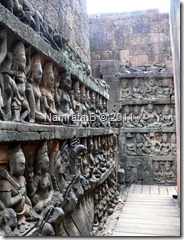 t. I had a lunch break to fortify myself before I went to some of the largest temples. Angkor Thom was the last and most enduring capital city of the Khmer empire. It was established in the late twelfth century by King Jayavarman VII. It covers an area of 9 km². It has a central road running through it, and structures, temples and trees on either side.The Terrace of Elephants with beautiful carvings, the Phimeanakas where the king spent the first watch of every night with a woman thought to represent a Nāga, the Baphuon which is under restoration & of course the famous Bayon. While there is a lot of walking involved, it’s also through very green patches, lawns, trees, shrubs & its quite pretty.
t. I had a lunch break to fortify myself before I went to some of the largest temples. Angkor Thom was the last and most enduring capital city of the Khmer empire. It was established in the late twelfth century by King Jayavarman VII. It covers an area of 9 km². It has a central road running through it, and structures, temples and trees on either side.The Terrace of Elephants with beautiful carvings, the Phimeanakas where the king spent the first watch of every night with a woman thought to represent a Nāga, the Baphuon which is under restoration & of course the famous Bayon. While there is a lot of walking involved, it’s also through very green patches, lawns, trees, shrubs & its quite pretty.
With its 54 towers, each with the head of Bayon on all four sides, there are 21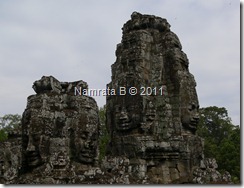 6 heads staring at you as you enter the Bayon temple! Who’s head is it? Well it may represent the king himself, the bodhisattva Avalokiteshvara, guardians of the empire’s cardinal points, or some combination of these. There are many steps & towers to go through and this one because of its popularity was full of tourists. No moments of solitude possible here. The main entrance to the Bayon – through which I exited – is grand and imposing with Devas & Asuras lined on either side of the road.
6 heads staring at you as you enter the Bayon temple! Who’s head is it? Well it may represent the king himself, the bodhisattva Avalokiteshvara, guardians of the empire’s cardinal points, or some combination of these. There are many steps & towers to go through and this one because of its popularity was full of tourists. No moments of solitude possible here. The main entrance to the Bayon – through which I exited – is grand and imposing with Devas & Asuras lined on either side of the road.
Does this sound exhausting? Well it was! And my day wasn’t over yet! A lot more to come culminating in the famous Angkor Wat – in the next post.